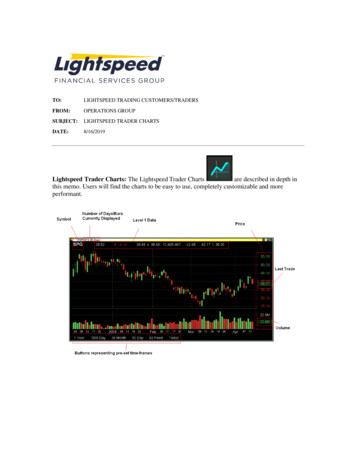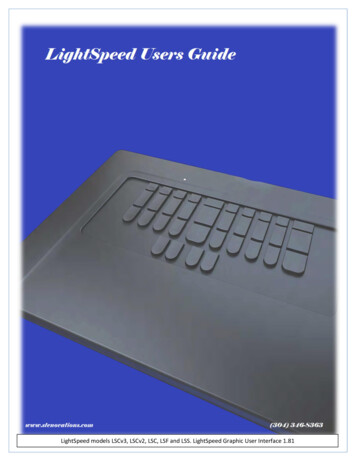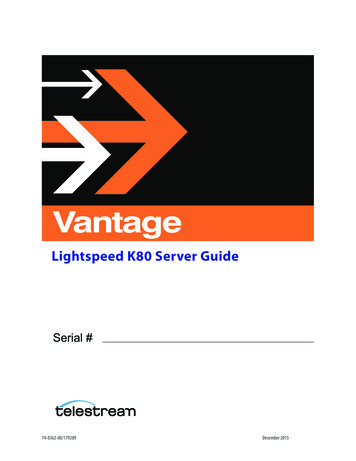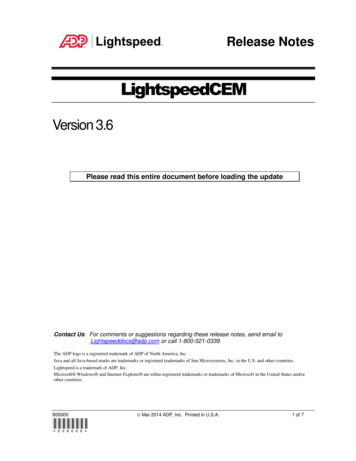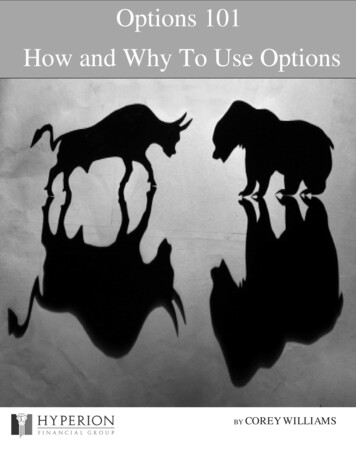
Transcription
OPTIONS 1011-888-577-3123 info@lightspeed.com www.lightspeed.com
Table of ContentsWhat are Options? 1Call Options 1Put Options 1Why Trade Options? 1Terminology of Options 1Understanding Basic Option Pricing 3Intrinsic Value 3Calculating the Intrinsic Value of Call Options 4Calculating the Intrinsic Value of Put Options 5Time Value 6Calculating Break-Even 7Calculating the Break-Even Point of Call Options 7Calculating the Break-Even on Put Options 8Long Call 9Basic Option Strategies 9When to Use 9Long Put 10Basic Option Strategies 10When to Use 10Futures and options trading involves the substantial risk of loss and is not suitable for all investors. Each investor mustconsider whether this is a suitable investment since you may lose all of or more than your initial investment. Pastperformance is not indicative of future results.1-888-577-3123 info@lightspeed.com www.lightspeed.com
Options 101Many people new to investing tend to shy away from trading options because they believe that they are difficult to learnand require a tremendous knowledge of mathematics. However, this is only true in the most complex option strategies.Many individuals find that once they have a better grasp of the vocabulary associated with options, they are much moreunderstandable and offer benefits that trading outright futures contracts do not.What are Options?An option is a contract that gives the buyer the right, but not the obligation, to go long (buy) or go short (sell) theunderlying futures contract at a specific price on or before a set expiration date. Essentially, options on futures allowan investor to participate in futures price moves without having to actually purchase a futures contract. There are twodifferent options: call and put options.Call OptionsCall options give the buyer the right, but not the obligation, to go long (buy) the underlying futures contract at a specificprice on or before a set expiration date. Buyers of call options want the underlying futures contract to move higher.Put OptionsPut options give the buyer the right, but not the obligation, to go short (sell) the underlying futures contract at a specificprice on or before a set expiration date. Buyers of put options want the underlying futures contracts to move lower.Why Trade Options?Trading options offers many advantages over trading outright futures contracts: Limited risk when purchasing options – when buying options on futures the most an investor can lose is thepremium paid for the options contract plus the transaction costs. Same opportunities as futures – certain options strategies provide the same opportunities as futures. Leverage – with options an investor can gain the same amount of leverage as an outright futures contract. Take advantage of any market condition – rallies, breaks, or sideways, by using various option strategies investorscan position themselves to take advantage of any market condition. Protection – options strategies can be used to hedge or protect other open positions.Terminology of OptionsPrior to trading options, it is important for investors to be familiar with several key terms associated with options:Strike price: Strike price is the price at which the option buyer (holder) may buy (go long) or sell (go short) the underlyingfutures contract. Strike price is also referred to as the exercise price.Premium: Premium is the amount paid by the options buyer (holder) to the options seller (writer) for the rights specified in1Back to Table of Contents1-888-577-3123 info@lightspeed.com www.lightspeed.com
Options 101the option contract. It is simply the option’s current market price or value. This value is affected by a number of differentfactors including the difference between the strike price and the underlying futures price, time left until expiration, and thevolatility of the underlying futures contract.Expiration Date: Expiration date is the last day in which an option can be liquidated or exercised into an underlying futuresposition. After this date, the option contract will cease to exist.Exercise: Exercise refers to the process in which an option buyer (holder) asserts their right to take a long or short positionin the underlying futures contact. Only the buyer can exercise an option. If an option is exercised, the seller (writer) isobligated to take the opposite futures position of the option buyer (holder). It is because of this risk that the option seller(writer) receives the option premium.Underlying Futures Contract: Underlying futures contract refers to the specific futures contract in which an investor will beassigned a position if the option is exercised.Intrinsic Value: Intrinsic value refers to the amount by which an option is in-the-money. It is the value of the option if it wereexercised today.Time Value: Time value refers to the portion of an option’s premium that is directly related to the amount of time leftbefore expiration as well as the overall volatility of the underlying futures contract. It is the amount by which an option’sprice exceeds the intrinsic value.Break-even Point: Break-even point refers to the price that the underlying futures contract must reach in order to avoid aloss if the option is exercised.In-the-money: In-the-money refers to the above situation in which the underlying futures price is above the call option’sstrike price or the underlying futures price is below the put option’s strike price. When an option is in-the-money, it doesnot necessarily mean the investor will profit from the position. It simply means that the option has intrinsic value.At-the-money: At-the-money refers to the situation in which the option’s strike price is the same as the underlying futurescontract price.Out-of-the-money: Out-of-the-money refers to the situation in which a call option’s strike price is above the underlyingfutures prices or a put option’s strike price is below the underlying futures price. An option that is out-of-the-money has nointrinsic value, only time value.2Back to Table of Contents1-888-577-3123 info@lightspeed.com www.lightspeed.com
Options 101Understanding Basic Option PricingBefore venturing into the world of trading options on futures, investors should have a basic understanding of the factorscomposing an option’s premium. When dissecting premium, the majority of people break it down into two generalcategories: intrinsic value and time value. Therefore, once an investor knows both the intrinsic value and the time value ofthe option contract the following equation can be used to calculate the option’s premium. (Illustration 1)Intrinsic ValueAs mentioned above, intrinsic value is the amount by which an option is in-the-money. It is important to note that intrinsicvalue cannot be negative. Thus, options trading at-the-money or out-of-the-money have an intrinsic value of zero.3Back to Table of Contents1-888-577-3123 info@lightspeed.com www.lightspeed.com
Options 101Calculating the Intrinsic Value of Call OptionsWith regard to calls, intrinsic value is the amount by which the underlying futures price exceeds the strike price. Theequation to the right can be used to calculate intrinsic value of a call. (Illustration 2)Example:Let’s say a trader is long 1 April gold 1700 call and April gold futures are currently trading at 1707.50 per troy ounce.What is the intrinsic value of the call option? (Illustration 3)4Back to Table of Contents1-888-577-3123 info@lightspeed.com www.lightspeed.com
Options 101Calculating the Intrinsic Value of Put OptionsWith regard to puts, intrinsic value is the amount by which the underlying futures price is below the strike price. Theequation to the right can be used to calculate the intrinsic value of a put. (Illustration 4)Example:Let’s say a trader is long 1 June crude oil 110.00 put and June crude oil futures are currently trading at 107.45 perbarrel. What is the intrinsic value of the put option? (Illustration 5)5Back to Table of Contents1-888-577-3123 info@lightspeed.com www.lightspeed.com
Options 101Time ValueTime value is the amount by which the option’s price exceeds the intrinsic value. As mentioned above, it accounts forthe amount of premium that is directly related to the amount of time left before expiration as well as the volatility of theunderlying futures contract. The more time an option has before expiration the greater the likelihood it will end up in-themoney. As more time passes, an option’s time value decays exponentially until reaching zero at expiration. As a generalrule of thumb, an option will lose one-third of its time value during the first half of its life and the remaining two-thirdsduring the second half. The equation below can be used to calculate the time value of an option contract. (Illustration 6)Example:Let’s say April live cattle are currently trading at 125.00 per contract and April 125 calls are currently at 2.50. What is thetime value of the call option? (Illustrations 7 & 8)6Back to Table of Contents1-888-577-3123 info@lightspeed.com www.lightspeed.com
Options 101Calculating Break-EvenAs mentioned above, the break-even point is the price that the underlying futures contract must reach in order to avoida loss if the option is exercised. While options are versatile instruments that allow the buyer to participate in marketfluctuations, it is imperative that an investor is able to calculate their break-even point prior to engaging in options trading.By calculating the break-even point of any given option position before entering, it assists the trader in evaluating andchoosing the most appropriate strategy for success. To calculate break-even, traders simply need to know the strike priceand the premium paid for the option.*Calculating the Break-Even Point of Call OptionsThis equation can be used for calculating the break-even point of a call option. (Illustration 9)Example:An investor purchases a December corn 6.00 call and pays a premium of 0.30. Calculate the break-even point of theoption position. (Illustration 10)In this example, the December corn futures would need to rise to 6.30 per bushel in order for the trader to break-even onthe position.7Back to Table of Contents1-888-577-3123 info@lightspeed.com www.lightspeed.com
Options 101Calculating the Break-Even on Put OptionsThe above equation can be used for calculating the break-even point of a put option. (Illustration 11)Example:An investor purchases a June E-Mini S&P 1200 put and pays a premium of 14.50. Calculate the break-even point of theposition. (Illustration 12)In this example, the June E-Mini S&P 500 futures would need to drop to 1185.50 in order for the trader to break-even onthe position.*Traders should also include in their break-even calculations any transaction costs paid as a result of the trade.8Back to Table of Contents1-888-577-3123 info@lightspeed.com www.lightspeed.com
Options 101Long CallBasic Option StrategiesBuying (or going long) call options is a bullish options strategy a trader can use. A long call gives investors the right topurchase the underlying futures contract at a specific price (strike price) on or before a set date (expiration date). Longputs offer the investor a limited risk with similar profit potential as the underlying futures contract. On a long call strategy,the investor only risks the premium paid for the option contract plus the transaction costs. The call option increases invalue as the underlying futures price increases. (Illustration 13)When to UseInvestors should consider the use of long call options when they believe a futures contract is set for a short-tern rise inprice. Buying call options is a bullish strategy.*Traders should also include their break-even calculations any transaction costs paid as a result of the trade.9Back to Table of Contents1-888-577-3123 info@lightspeed.com www.lightspeed.com
Options 101Long PutBasic Option StrategiesBuying (or going long) put options is a bearish options strategy a trader can use. A long put gives investors the right to sellthe underlying futures contract at a specific price (strike price) on or before a set date (expiration date). Long puts offerthe investor a limited risk with similar potential as the underlying futures contract. On a long put strategy, the investoronly risks the premium paid for the option plus the transaction costs. The put option increases in value as the underlyingfutures price decreases. (Illustration 14)When to UseInvestors should consider the use of long put options when they believe a futures contract is set for a short-term drop inprice. Buying put options is a bearish market strategy.*Traders should also include in their break-even calculations any transaction costs paid as a result of the trade.10Back to Table of Contents1-888-577-3123 info@lightspeed.com www.lightspeed.com
Options 101 Calculating the Break-Even on Put Options The above equation can be used for calculating the break-even point of a put option (Illustration 11) Example: An investor purchases a June E-Mini S&P 1200 put and pays a premium of 14.50. Calculate the break-even point of the
